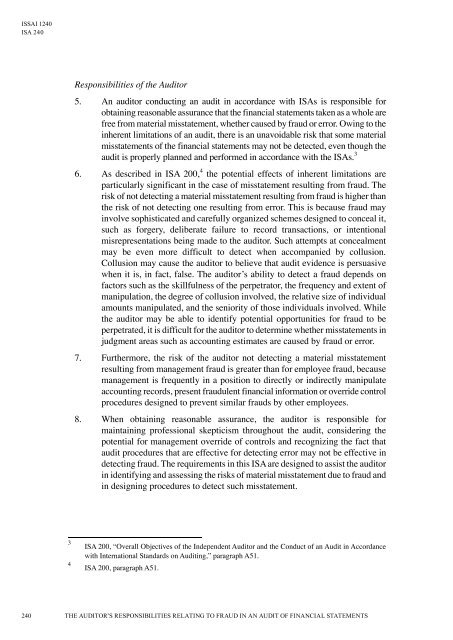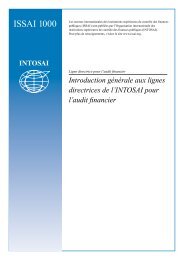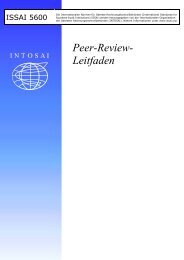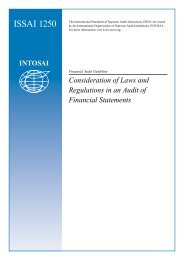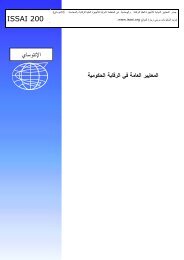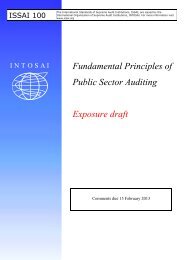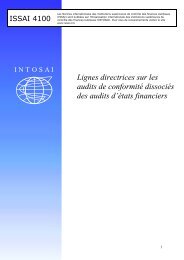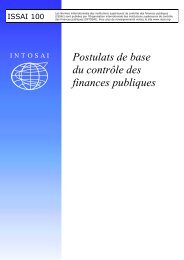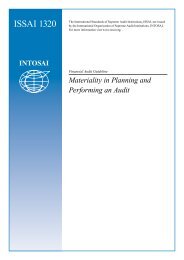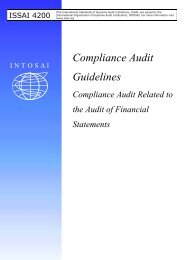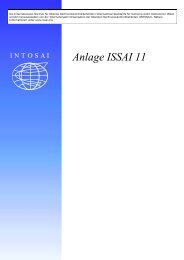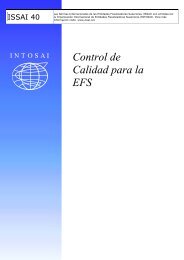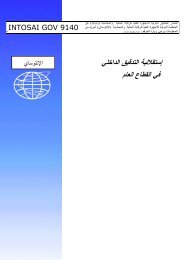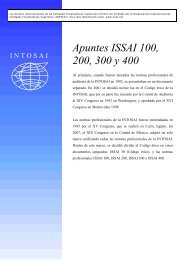ISSAI 1240
ISSAI 1240
ISSAI 1240
Create successful ePaper yourself
Turn your PDF publications into a flip-book with our unique Google optimized e-Paper software.
<strong>ISSAI</strong> <strong>1240</strong><br />
ISA 240<br />
THE AUDITOR’S RESPONSIBILITIES RELATING TO<br />
FRAUD IN AN AUDIT OF FINANCIAL STATEMENTS<br />
Responsibilities of the Auditor<br />
5. An auditor conducting an audit in accordance with ISAs is responsible for<br />
obtaining reasonable assurance that the financial statements taken as a whole are<br />
free from material misstatement, whether caused by fraud or error. Owing to the<br />
inherent limitations of an audit, there is an unavoidable risk that some material<br />
misstatements of the financial statements may not be detected, even though the<br />
audit is properly planned and performed in accordance with the ISAs. 3<br />
6. As described in ISA 200, 4 the potential effects of inherent limitations are<br />
particularly significant in the case of misstatement resulting from fraud. The<br />
risk of not detecting a material misstatement resulting from fraud is higher than<br />
the risk of not detecting one resulting from error. This is because fraud may<br />
involve sophisticated and carefully organized schemes designed to conceal it,<br />
such as forgery, deliberate failure to record transactions, or intentional<br />
misrepresentations being made to the auditor. Such attempts at concealment<br />
may be even more difficult to detect when accompanied by collusion.<br />
Collusion may cause the auditor to believe that audit evidence is persuasive<br />
when it is, in fact, false. The auditor’s ability to detect a fraud depends on<br />
factors such as the skillfulness of the perpetrator, the frequency and extent of<br />
manipulation, the degree of collusion involved, the relative size of individual<br />
amounts manipulated, and the seniority of those individuals involved. While<br />
the auditor may be able to identify potential opportunities for fraud to be<br />
perpetrated, it is difficult for the auditor to determine whether misstatements in<br />
judgment areas such as accounting estimates are caused by fraud or error.<br />
7. Furthermore, the risk of the auditor not detecting a material misstatement<br />
resulting from management fraud is greater than for employee fraud, because<br />
management is frequently in a position to directly or indirectly manipulate<br />
accounting records, present fraudulent financial information or override control<br />
procedures designed to prevent similar frauds by other employees.<br />
8. When obtaining reasonable assurance, the auditor is responsible for<br />
maintaining professional skepticism throughout the audit, considering the<br />
potential for management override of controls and recognizing the fact that<br />
audit procedures that are effective for detecting error may not be effective in<br />
detecting fraud. The requirements in this ISA are designed to assist the auditor<br />
in identifying and assessing the risks of material misstatement due to fraud and<br />
in designing procedures to detect such misstatement.<br />
3<br />
4<br />
ISA 200, “Overall Objectives of the Independent Auditor and the Conduct of an Audit in Accordance<br />
with International Standards on Auditing,” paragraph A51.<br />
ISA 200, paragraph A51.<br />
5<br />
240 The Auditor’s Responsibilities Relating to Fraud in an Audit of Financial Statements


